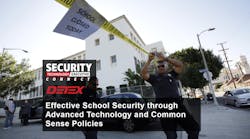New generation of weapons detection peace of mind for Louisiana school
Russell Marino, a former Air Force pilot, would have no problem sacrificing his life to protect those of innocent children and adults at Hosanna Christian Academy, where he serves as executive director.
But after instituting a extended list of physical security measures at HCA that were successful, recent mass shootings in the U.S. convinced him another step was needed.
School officials opted to implement a system from Athena Security for screening as people enter through a single point of entrance in the school’s front office. The system uses high-definition metal detection and other sensors to understand the type, shape, and size of metal in transit through the system to identify metallic threats.
The company says the system can spot the difference between innocuous items (such as keys, phones, metal water bottles) and legitimate hazards. Marino wanted a system that passed the government standards for weapons detection and provided a high level of threat detection without screaming high-risk area.
“Russ and his school are kind of more first movers,” explains Lisa Falzone, co-founder and president of Athena Security. “I would like to see this technology in more schools than it currently is. I think we could save a lot of lives and keep schools from looking like a jail as well.”
Attention to Detail
Hosanna Christian Academy was founded in 1978 as a small, private Christian school which began with a pre-K and Kindergarten program. HCA added one more grade level each year through the first graduating class of 1992.
After more than two decades serving K-12 students, HCA chose to on children in pre-K through 8th grade. The school serves about 450 students and employs several dozen educators and support staff, with smaller class sizes comparatively than public schools or private and parochial schools in Baton Rouge.
Marino, 75, has served the school for 12 years and worked as director for the last eight. When he took over as director, he had already served for 3 years as chief operations officer and dean of students and reviewing the campus from a safety standpoint was one of his most important duties.
He says his time in the military taught him that attention to detail and safety must be at the forefront of everything that is done with aircraft. “When I look at things, I look at it globally and then try to see where the potential threats are practically and otherwise,” Marino says.
The decision to choose a weapons detection system was not immediate, as Marino had taken steps to secure the grounds through the presence of three armed administrators -- including Marino, an assistant principal and another citizen who had concealed-carry permits for weapons.
A ‘Hardened’ Campus
Marino said the three of them discussed how they would operate in a threat scenario, how to cover different zones and contingencies, knowing it would give them a better opportunity to limit or prevent loss of life that is often maximized in the first two to three minutes of school shootings.
The campus is surrounded by a six-foot chain-link perimeter fencing topped with two feet of barbed wire. Administrators put up signs at school entrances warning armed personnel were at the school willing to meet any threat in a lethal manner.
“I’m not bashful about that,” Marino says “I want this to be a hardened campus. There are, unfortunately, a lot of schools that have multiple access points around their campus that are not able to fence them or not gotten to where they’d even consider a metal detection system.”
Marino drafted procedures to close traffic gates once the tardy bells rang and the line of cars dropping off or picking up students dissipated. When classes start, all walk gates are closed and locked automatically and all exterior doors lock automatically as well.
The campus has 65 security cameras, which are placed in every classroom and hallway, at the pickup and drop-off points and at the front office entrance. Several staff in their offices have monitors, and Marino typically has 16 feeds pulled up on his desktop monitor representing key spots where he feels a perpetrator may attempt to breach the campus perimeter.
Controlling entry points with keys or codes needed for access were another way to secure the campus. It was designed in part to slow down a threat if they’ve made it onto campus. Marino also installed magnetic locks on key doors -- in particular, the front office and entrance to the K-2 building a couple of years ago.
“With the mag-lock system being controlled by the receptionist who has cameras and intercoms to whoever’s at that door wanting to get entrance, we have again, a way to slow down someone trying to come in through primary access points,” he said.
"I’ve literally had a lot of smiling parents. They know we’ve got this system and what it’s for."
In addition, the decision was made to have a single point of entry on campus. And knowing many school shooters have tried to go into areas where there are groups of students, like a dining hall or library for maximum impact, HCA also makes use of the Rave communications app -- an emergency communications system that teachers and employees have on their phone allowing instantaneously dispatching of police during an incident.
“That’s a very handy thing that can get quick response going even if it's something that we're not aware of it because it's on the back end of the campus or something, or a playground area,” Marino says. “We also have a silent alarm system in the front office that would go directly to police dispatch and they would do that without any alarms going off.”
A Final Layer
With school and church shootings happening more frequently in recent years, Marino states that these incidents forced him to analyze and absorb the lessons in vulnerability to determine where HCA’s campus might still be at risk.
The hope, Marino says, is that with multiple layers of security a perpetrator will opt not to attempt something on his campus because of the myriad obstacles to deal with. But if they gain access through the single point of entry at the school, he decided another layer of protection was needed.
Although his receptionist can vet someone outside the door if it’s somebody who is known, it may not be clear they’re thinking of doing something dramatic. Although metal detectors and hand-held wands are popular in secured public places like airports and courthouses, Marino feels this approach wasn’t practical at the school and might not meet the needed comfort level for parents or students.
HCA school hours run from 6:45 a.m. to 3:30 p.m., so parents are driving onto campus to drop off their children and they come back to pick them up. There are aftercare programs on campus from 3:30-5:30 p.m., where students which also creates heavy traffic. The campus has several buildings, including a large church. “So whatever we were going to do needed to account for the multiple things going on,” Marino adds.
Researching a weapons detection systems for HCA was, “one of the last things that I would’ve even considered doing,” Marino says.
Slowing Down the Suspect
When the Athena system is triggered it sets off an audible alert. The device captures an image of the person and is transferred to an iPad and made available to HCA’s three-member security team.
“If our receptionist sees it go off and she realizes this is a threat, she just literally touches the iPad on her desk and she can basically say it’s not a threat, don’t worry about it, or it is a threat,” Marino says.
Marino said there was a learning curve as the technology was implemented but it has worked as it should and no weapons have been identified as of December.
He says the system accounts for all the metal on a person and if someone with a large amount of jewelry or a plus-size iPhone and keys or other items goes through, the alarm may sound. There is some calibration needed to set the system’s sensitivity for the right situation.
Marino says he hasn’t had any complaints about the technology from parents. He went as far sending a link to a recent TV story about the system to parents so they were aware of it.
“I’ve literally had a lot of smiling parents,” Marino says. “They know we’ve got this system and what it’s for.”





